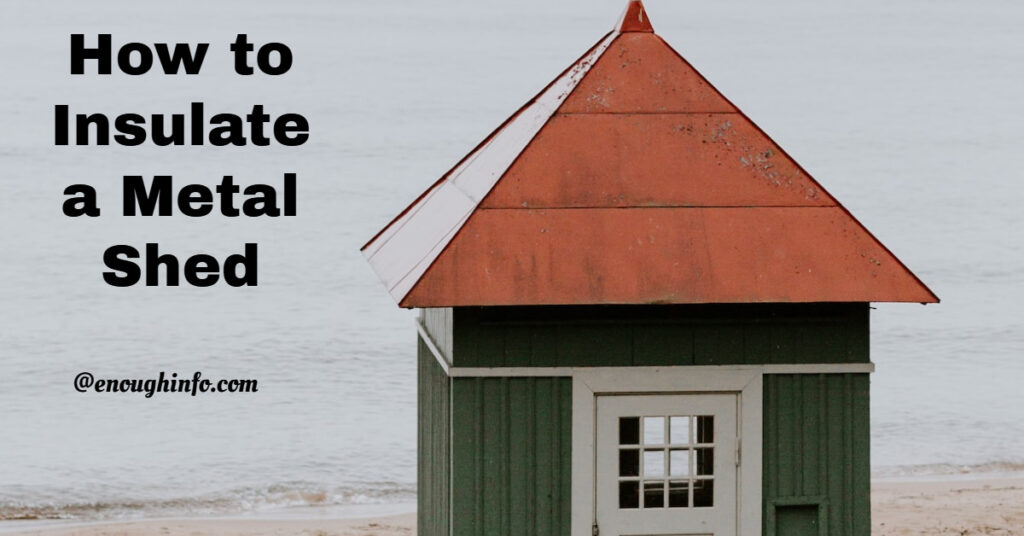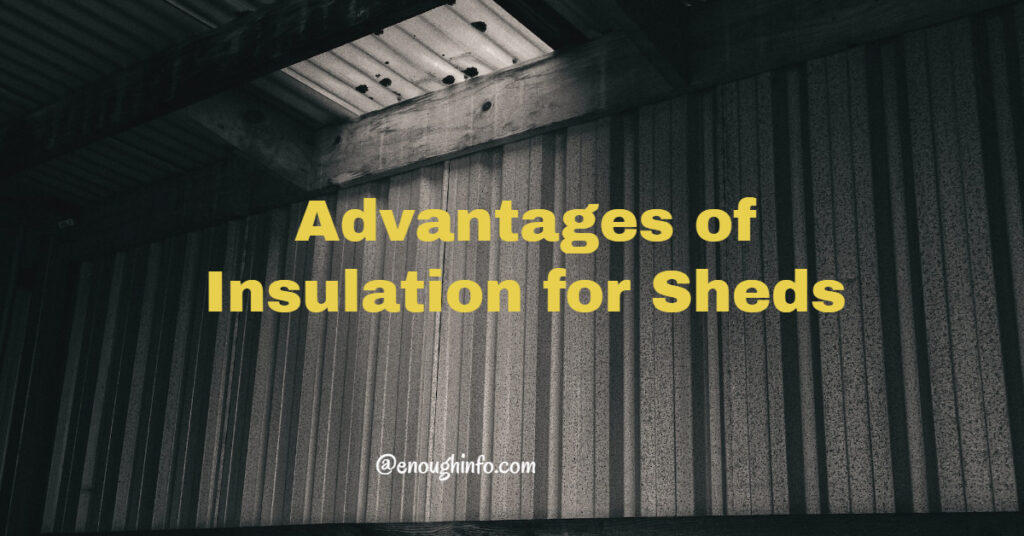
How to Insulate a Metal Shed. If you want an outdoor storage solution that is strong and requires no upkeep, a metal shed is a great option. Purchasing an insulated shed is a smart choice whether you want to keep it in top condition or spend hours every day in the shed potting plants and preparing seeds.

Professional insulation of a shed is an option, but with a little DIY know-how, you may discover how to insulate a metal shed to protect your possessions from the weather by managing the inside temperature of the shed. We can also walk you through the process of insulating the roof of your metal shed.
Learn more about how an insulated shed might benefit your property by offering a dependable outdoor storage solution before starting this procedure.
How to Insulate a Metal Shed
Although it is not difficult, insulating your metal shed properly might take a lot of time, so allow yourself most of the day to complete the task. This is how:
- Your metal shed’s wall, ceiling, and floor areas should be measured.
- If necessary, remove the internal wall sheathing.
- Apply two-inch thicknesses of closed-cell spray foam to the walls.
- Between layers, let the foam dry.
- In the same way, apply closed-cell spray foam to the ceiling.
- Await the foam’s drying off.
- Lift the shed to place stiff foam floor panels.
- Alternately, take down the floor and insert firm foam panels in between the joists.
- If necessary, reinstall the inside sheathing and flooring.
Here’s how to use spray foam with closed cells to insulate a metal shed:
- Take everything out of your shed.
- Apply plastic tape to all windows, vents, outlets, switches, and other openings.
- Interior walls and ceilings should be cleaned, followed by a thorough drying process.
- Wear your safety equipment according to the instructions on the spray foam kit.
- Use the foam as instructed. From the top, work your way down to the bottom, starting with the ceiling.
- Use a picture-frame layout and fill the middle of the stud cavities last if the shed has them.
- Make sure you spray in layers no thicker than 2″ at once. By doing more, a fire risk may arise. Before adding extra layers, let the foam dry.
- After finishing the interior, you should, if at all possible, insulate the underside of your metal shed.
- Use a small tractor or a jack to raise your shed.
- Apply the spray foam using the same technique you used inside. Make sure the bottom is once more clear and debris-free before applying.
- Remove the floor panels of your shed if you can’t get below it. You can spray between the joist cavities if the entire shed is supported by a backing. If not, stiff foam will have to be used.
If spray foam is too expensive to purchase, ISO rigid foam boards would be the next-best option for insulating the interior of your metal shed. Here is how to use ISO foam boards for insulation:
- Remove everything from your shed’s interior.
- Calculate the size of the room’s walls and ceiling. You need precise measurements since foam needs to fit tightly.
- Your foam board should be cut to fit stud cavities. If you don’t have studs, you can cut foam to fit the height of your shed’s walls by standing it vertically. Make sure the fit is snug but not so snug that the foam is distorted. You can layer your foam as much as you like, but make sure that extra layers are added to compensate for gaps in the foam board. This guarantees ideal insulation.
- The foam should be put in the ceiling. To fit tightly between rafters, cut foam pieces. If there are no rafters, you can attach foam board to the ceiling using construction adhesive or strapping.
- Measure the joist cavities if you have access to the underside of your metal shed. To fit between joists, cut the foam. If there are no joists, place the boards so that they completely cover the shed floor. Foam can be layered once more to increase the R-value.
- Remove the shed’s floor if you are unable to access the underneath of the structure. Place the stiff foam in the spaces between the joists. As an alternative, you might place the foam over the joists all at once. Put the foam board over the entire area if there are no joists, then reinstall the flooring.
Advantages of Insulation for Sheds

An insulated shed is great for your backyard for several reasons. When determining whether to insulate a shed, keep the following advantages in mind:
Dealing with Humidity
Humidity can do serious damage to both your shed and the items stored inside. Temperature changes can lead to condensation, which can harm the building’s structure and eventually lead to rust and its destruction. The temperature is stabilized in an insulated shed, which helps fight the problems that humidity can bring about.
Reduce noise
Are you going to use any loud tools in the shed? It’s possible that neither your housemates nor your neighbors like the way it sounds. If you live close to your neighbors, you might want to consider adding shed insulation to lower the noise level.
Keep insects away
An insulated shed is essential if storage is one of your primary motivations for purchasing a metal shed. If you’re not careful, pests may get into your furniture, seasonal things, or children’s toys. By insulating a shed, you can keep your possessions secure and avoid using pricy pest control measures.
Temperature regulation
You can spend a lot of time inside if you intend to use your shed to garden or simply to relax in your outdoor space. The metal shed is a fantastic conductor of energy, regardless of the season—hot summer or chilly winter. This implies that, depending on the outside temperature, it will remain extremely hot or chilly.
While you labor over your plants, a well-insulated shed can help to maintain the temperature and provide a more comfortable environment. This also implies that whatever you store within will be protected from extremely cold temperatures.
Conclusion.
Keep in mind that moisture is your worst enemy while adding insulation to your metal shed. Regardless of whether you use spray foam or ISO rigid foam boards, a suitable vapor barrier and adequate ventilation should always be present.
Make sure you adhere to all safety precautions as described in the kit’s instructions before putting spray foam. Despite being a useful product, spray foam contains several chemicals that might harm your eyes and lungs. When using it on your own, be cautious.
Read Also:
How To Create A DIY Home Decor On A Budget
Best Foods To Boost Testosterone(2023 Guide)
How To Make Homemade Body Lotion(The Best Guide)




